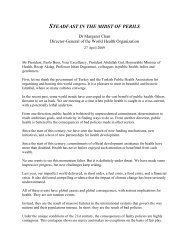The Evolution of HTA in Emerging Markets Health-Care ... - TREE
The Evolution of HTA in Emerging Markets Health-Care ... - TREE
The Evolution of HTA in Emerging Markets Health-Care ... - TREE
Create successful ePaper yourself
Turn your PDF publications into a flip-book with our unique Google optimized e-Paper software.
OHE Consult<strong>in</strong>g Report for PhRMA<br />
5 January 2011<br />
given the exist<strong>in</strong>g <strong>in</strong>stitutional arrangements, what is the appropriate direction for policy changes<br />
that will facilitate the function<strong>in</strong>g <strong>of</strong> health systems <strong>in</strong> ways that are publicly accountable, or at least,<br />
accountable to the population covered by each healthcare payer/purchaser. Irrespective <strong>of</strong><br />
whatever is considered ‘theoretically best’, the start<strong>in</strong>g po<strong>in</strong>t for policy analysis and reform <strong>in</strong> any<br />
particular country is the exist<strong>in</strong>g system.<br />
Figure 1: Framework for understand<strong>in</strong>g healthcare purchasers/<strong>in</strong>surers: Kutz<strong>in</strong> (2001)<br />
5.3 Functions <strong>of</strong> health systems<br />
Related to Kutz<strong>in</strong>’s (2001) work is Murray and Frenk’s (2000) framework for assess<strong>in</strong>g health system<br />
performance. Although, this framework doesn’t actually <strong>of</strong>fer a taxonomy <strong>of</strong> healthcare systems, it is<br />
useful tool for understand<strong>in</strong>g the vary<strong>in</strong>g differences between healthcare systems <strong>in</strong> terms <strong>of</strong> four<br />
functions that all healthcare system perform irrespective <strong>of</strong> their heterogeneity and <strong>of</strong> differences <strong>in</strong><br />
underly<strong>in</strong>g philosophical and economic rationales for health system design. <strong>The</strong> four functions <strong>of</strong><br />
healthcare systems are depicted below <strong>in</strong> Figure 2. Note that this framework is the same one used<br />
by Mossialos, et al. (2002) <strong>in</strong> the monograph “<strong>Health</strong>care fund<strong>in</strong>g options <strong>in</strong> Europe”. <strong>The</strong> four<br />
functions <strong>of</strong> health systems are: (1) F<strong>in</strong>anc<strong>in</strong>g (2) Provision (3) Stewardship, and (4) ‘Resource’<br />
generation. Given the importance <strong>of</strong> this framework we set out below more detail on the <strong>in</strong>dividual<br />
components.<br />
F<strong>in</strong>anc<strong>in</strong>g: <strong>The</strong>re are three dimensions to this: (1) revenue collection (2) fund pool<strong>in</strong>g and (3)<br />
purchas<strong>in</strong>g tasks. Revenue collection refers to mobilization <strong>of</strong> needed f<strong>in</strong>ance for medical care<br />
provision. Pool<strong>in</strong>g refers to the extent <strong>of</strong> any redistributive and <strong>in</strong>surance element <strong>of</strong> the system <strong>in</strong><br />
which revenues are collected <strong>in</strong> ways that ensure fairness <strong>in</strong> f<strong>in</strong>ancial contribution and used <strong>in</strong> a way<br />
which provides health <strong>in</strong>surance protection. Purchas<strong>in</strong>g refers to the process by which revenues<br />
collected are transferred to healthcare providers for the provision <strong>of</strong> medical services. It can be<br />
passive (for example meet<strong>in</strong>g fee-‐for-‐service claims from providers) or active (agree<strong>in</strong>g what will be<br />
bought and negotiat<strong>in</strong>g payments with providers.) In between could come purchas<strong>in</strong>g tasks such as<br />
25








